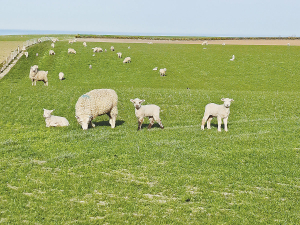University of Waikato research reveals 2050 drought threats
New research could help farmers prepare for a future where summer rainfall is increasingly unpredictable and where drought risk is rising, no matter what.
 Expected dry weather along the east coast of both islands builds a strong case for weaning at least a proportion of the lamb crop early.
Expected dry weather along the east coast of both islands builds a strong case for weaning at least a proportion of the lamb crop early.
A predicted dry summer, thanks to El Nino weather patterns, may make weaning a proportion of the lamb crop a good option this season.
The prospect of hot, dry weather along the east coast of both islands builds a strong case for weaning at least a proportion of the lamb crop early. This will allow high-quality feed to be partitioned into lambs while ewes recover body condition. It also provides the opportunity to sell cull ewes early.
Trials run at Massey University found lambs over 20kg LW coped best with early weaning (minimum weaning weight was 16kg LW). However, it was the quality of the forages on offer that was the greatest determinant of how well lambs grew post-weaning.
Professor Paul Kenyon, who led the early-weaning trials, says early weaned lambs should be given unrestricted access to legumebased forages such as a herb clover mix at a minimum cover of seven centimetres in height.
If lambs are weaned onto the crop, they should be given time to adjust to a change in feed. Running the ewe and lambs onto the crop a few days before weaning, then running the lambs back onto the crop after weaning will help minimise the weaning check.
He says in late lactation all lambs, but especially multiples, are receiving very little nutrition from the ewe, so when grass-growth is limited the ewes are competing with their lambs for feed, compromising the performance of both.
Early weaning can also be particularly useful in hoggets as it will give them more time to recover body condition between lambing and mating again as a two-tooth.
Partitioning high quality feed into lambs in the late spring early summer period will benefit the whole farm system. It means more lambs can be sold prime before the height of summermaking more feed available for capital stock – and ewe lambs can be grown out to heavier weights early. This means there is flexibility to hold them back later when feed resources are more limited.
With the current situation in the European farm machinery market being described as difficult at best, it’s perhaps no surprise that the upcoming AgriSIMA 2026 agricultural machinery exhibition, scheduled for February 2026 at Paris-Nord Villepinte, has been cancelled.
The Meat Industry Association of New Zealand (MIA) has launched the first in-market activation of the refreshed Taste Pure Nature country-of-origin brand with an exclusive pop-up restaurant experience in Shanghai.
Jayna Wadsworth, daughter of the late New Zealand wicketkeeper Ken Wadsworth, has launched an auction of cricket memorabilia to raise funds for I Am Hope's youth mental health work.
As we move into the 2025/26 growing season, the Tractor and Machinery Association (TAMA) reports that the third quarter results for the year to date is showing that the stagnated tractor market of the last 18 months is showing signs of recovery.
DairyNZ chair Tracy Brown is urging dairy farmers to participate in the 2026 Levy vote, to be held early next year.
Beef + Lamb New Zealand (B+LNZ) is calling for nominations for director roles in the Eastern North Island and Southern South Island electoral districts.